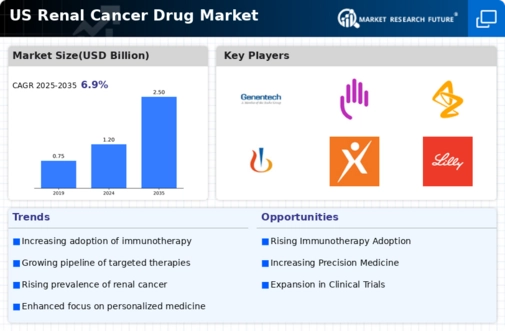The competitive landscape of the US Renal Cancer Drug Market is characterized by the presence of several key players who are actively involved in the development, production, and marketing of therapies aimed at treating renal cancer. This market is influenced by a myriad of factors including advancements in research and development, the introduction of novel therapies, regulatory policies, and an increasing emphasis on personalized medicine.
The market landscape is vibrant, with companies striving to enhance their portfolios and strengthen their market positions through strategic collaborations, partnerships, and investments. The competitive dynamics are further intensified by ongoing clinical trials aimed at proving the efficacy of new compounds, which play a crucial role in determining market share and the overall competitive edge these companies hold within the industry.
Merck and Co is significantly positioned within the US Renal Cancer Drug Market, boasting a robust portfolio that emphasizes innovation and efficacy in its therapies. The company holds a competitive advantage through its strong emphasis on research and development, which enables it to stay at the forefront of therapeutic breakthroughs.
Merck and Co actively engages in various clinical trials aimed at enhancing the treatment landscape for renal cancer, showcasing its commitment to improving patient outcomes. The company benefits from vast resources, strong financial backing, and an established reputation that contributes to its market presence.
Furthermore, Merck and Co’s dedication to fostering collaborations with research institutions and healthcare professionals strengthens its ability to navigate the competitive landscape effectively, allowing it to respond rapidly to emerging trends and demands in the renal cancer treatment arena. Genentech has carved out a notable presence in the US Renal Cancer Drug Market, focusing on providing targeted therapies that address the specifics of renal cancer treatment.
The company is known for its robust pipeline of innovative medicines, which are the result of extensive investments in research and development. Key products and services include therapies that have shown promise in clinical trials, placing Genentech in a competitive position to advance treatment options for renal cancer patients.
The firm has also made strategic mergers and acquisitions that have bolstered its market presence and expanded its product offerings in this area. Through these endeavors, Genentech not only enhances its therapeutic portfolio but also solidifies its standing as a leader in the renal cancer treatment landscape. Its strengths lie in a strong reputation for drug development, a commitment to innovation, and a strategic approach to collaborations that allow for a more effective response to the evolving needs of the healthcare sector.





















